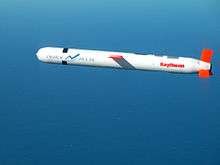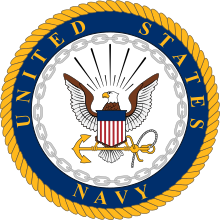Naval Air Systems Command
The Naval Air Systems Command (NAVAIR) provides material support for aircraft and airborne weapon systems for the United States Navy. It is one of the various Navy systems commands, and was established in 1966 as the successor to the Navy's Bureau of Naval Weapons.
| Naval Air Systems Command | |
|---|---|
 Seal of the Naval Air Systems Command | |
| Country | |
| Branch | |
| Type | Systems Command |
| Role | Naval warfare, Naval Aviation |
| Headquarters | Naval Air Station Patuxent River Patuxent River, Maryland, U.S. |
| Website | www |
| Commanders | |
| Commander | Vice Admiral G. Dean Peters |
| Vice Commander | Rear Admiral (Lower Half) (Sel) John S. Lemmon |
| Deputy Commander | Garry R. Newton (CIV) |
| Aircraft flown | |
| Attack | AV-8B Harrier |
| Electronic warfare | EA-6B Prowler, E/A-18G Growler |
| Fighter | F-14 Tomcat, F/A-18 Hornet, F/A-18E/F Super Hornet, F-35 Lightning II |
| Multirole helicopter | Sikorsky SH-60 Sea Hawk |
| Patrol | P-3 Orion, P-8 Poseidon |
| Trainer | T-45 Goshawk |

NAVAIR is headquartered in Naval Air Station Patuxent River in St. Mary's County, Maryland, with military and civilian personnel stationed at eight locations across the continental United States and one site overseas. The current commander as of 31 May 2018 is Vice Admiral G. Dean Peters.[1] The vice commander is Rear Admiral (Lower Half) (Sel) John S. Lemmon.[2] The deputy commander, or senior civilian service member, is Mr. Garry R. Newton.[3]
NAVAIR's mission is to provide full life-cycle support of naval aviation aircraft, weapons and systems operated by Sailors and Marines. This support includes research, design, development and systems engineering, acquisition, test and evaluation, training facilities and equipment, repair and modification, and in-service engineering and logistics support.
NAVAIR is organized into eight "competencies" or communities of practice namely: program management, contracts, research and engineering, test and evaluation, logistics and industrial operations, corporate operations, comptroller and counsel.
The competency alignment of the organization is changing to "mission alignment." [4]
NAVAIR provides support (through people, processes, tools, training, mission facilities, and core technologies) to Naval Aviation Program Executive Officers (PEOs) and their assigned program managers, who are responsible for meeting the cost, schedule, and performance requirements of their assigned programs.
Program Executive Offices (PEO)
The Naval Air Systems Command is organizationally aligned to the Chief of Naval Operations. As part of its mission, NAVAIR provides support, manpower, resources, and facilities to its aligned Program Executive Offices (PEO's). The Program Executive Offices are responsible for the execution of major defense acquisition programs. The PEO's are organizationally aligned to the Assistant Secretary of the Navy for Research, Development and Acquisition (ASN(RDA)). The Naval Aviation PEO's are co-located with the Naval Air Systems Command, and operate under NAVAIR policies and procedures. Other PEO's, such as the Office of the Secretary of Defense's direct reporting Program Executive Office, Joint Strike Fighter (PEO(JSF)) also obtain support, manpower, laboratories and facilities from NAVAIR.
Naval Aviation PEOs are:
Program Executive Officer, Tactical Programs (PEO(T))
The following Program Offices are responsible to PEO(T):
- PMA-213: Naval Air Traffic Management Systems Program
- PMA-231: E-2/C-2 Airborne Command and Control Systems Program
- PMA-234: Airborne Electronic Attack Program
- PMA-251: Aircraft Launch and Recovery Equipment Program
- PMA-257: AV-8B V/STOL Attack Program
- PMA-259: Air-To-Air Missiles Program
- PMA-265: F/A-18 and EA-18G Program
- PMA-272: Advanced Tactical Aircraft Protection Systems Program
- PMA-273: Naval Undergraduate Flight Training Systems Program
Program Executive Officer, Assault and ASW Programs (PEO(A))
The following Program Offices are responsible to PEO(A):
- PMA-207: Tactical Airlift Program Systems Program
- PMA-261: H-53 Helicopter Program
- PMA-264: Air Anti-Submarine Warfare Systems Program
- PMA-271: Airborne Strategic Command, Control and Communications Program
- PMA-274: Presidential Helicopters Program
- PMA-275: V-22 Joint Program
- PMA-276: H1 Program
- PMA-290: Maritime Patrol and Reconnaissance Aircraft (MPRA) Program
- PMA-299: H-60 Multi-mission Helicopter Program

Program Executive Officer, Unmanned Aviation and Strike Weapons (PEO(U&W))
The following Program Offices are responsible to PEO(U&W):
- PMA-201: Precision Strike Weapons Program
- PMA-208: Aerial Targets Program
- PMA-242: Direct and Time Sensitive Strike Program
- PMA-262: Persistent Maritime Unmanned Aircraft Systems Program
- PMA-263: Small Tactical Unmanned Aircraft Systems Program
- PMA-266: Multi-Mission Tactical Unmanned Aerial Systems (UAS) Program
- PMA-268: Unmanned Carrier Aviation Program
- PMA-280: Tomahawk Weapons System Program
- PMA-281: Strike Planning and Execution Systems Program
Naval Aviation Enterprise
NAVAIR is part of the Naval Aviation Enterprise triad model currently headed by the Commander, Naval Air Forces (CNAF) and supported by the OPNAV Director, Naval Air Warfare.
Naval Air Warfare Centers (NAWC)
See also Naval Air Warfare Center.
Naval Air Warfare Center Aircraft Division (NAWCAD)
NAWCAD is the center for Aircraft Systems Development and Testing. The following two locations makeup NAWCAD:
- Naval Air Station Patuxent River, MD
- Naval Air Engineering Station Lakehurst, NJ
Naval Air Warfare Center Training Systems Division (NAWC-TSD)
NAWC-TSD is the center for development of simulation-based training systems. NAWC-TSD is currently located in Orlando, FL.
Naval Air Warfare Center Weapons Division (NAWCWD)
NAWCWD is the center for Weapons Systems and Energetics Development and Testing. The following two locations makeup NAWCWD:
Fleet Readiness Centers (FRC)
Fleet Readiness Centers are support activities that provide shore-based and depot level maintenance and support to the Navy's aviation effort. They are directed under the office of Commander, Fleet Readiness Centers (COMFRC).
Below are the following Fleet Readiness Centers:
- FRC East, Marine Corp Air Station Cherry Point, NC
- FRC Mid-Atlantic, Naval Air Station Oceana, VA
- FRC Northwest, Naval Air Station Whidbey Island, WA
- FRC Southeast, Naval Air Station Jacksonville, FL
- FRC Southwest, Naval Air Station North Island, CA
- FRC West, Naval Air Station Lemoore, CA
- FRC Western Pacific, Naval Air Facility Atsugi, Japan
See also
Comparable organizations
U.S. Navy
- Marine Corps Systems Command
- Naval Sea Systems Command
- Space and Naval Warfare Systems Command
- Naval Facilities Engineering Command
- Naval Supply Systems Command
Footnotes
- "Commander, Naval Air Systems Command, Vice Adm. David A. Dunaway". Naval Air Systems Command, United States Navy. Archived from the original on 12 December 2012. Retrieved 26 November 2012.
- "Vice Commander, Naval Air Systems Command, Rear Adm. Kirby D. Miller". Naval Air Systems Command, United States Navy. Archived from the original on 12 December 2012. Retrieved 26 November 2012.
- "Deputy Commander, Naval Air Systems Command, Mr. Kalman I. Leikach". Naval Air Systems Command, United States Navy. Archived from the original on 12 December 2012. Retrieved 26 November 2012.
- NAVAIR Commander's Update: Expectations for 2019, retrieved 25 September 2019
External links
- NAVAIR official website
- NAVAIR locations
- NAVAIR at Joint Base McGuire-Dix-Lakehurst. See also Joint Base McGuire-Dix-Lakehurst.
